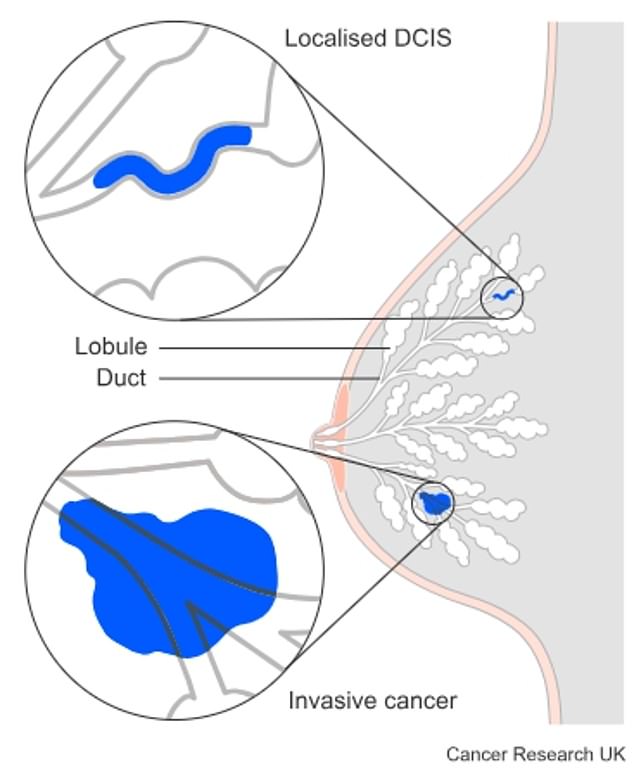Table of Contents
‘Boy Meets World’ actress Danielle Fishel is urging other women to get mammograms after revealing her breast cancer diagnosis.
The 43-year-old Arizona woman said on her podcast that she had ductal carcinoma in situ, or DCIS, a type of breast cancer that affects the milk ducts.
It is stage 0, has not spread to other areas of the body and will be treated with surgery; Fishel is believed to have a good prognosis.
But the mother of two says the cancer, which caused no symptoms, would have gone undetected if she had not kept her mammogram appointment.
Fishel has hosted Pod Meets World with her former Boy Meets World co-stars Will Friedle and Rider Strong since 2022; pictured here in 2022

The graphic above shows the difference between ductal carcinoma in situ (DCIS) and invasive breast cancer.
Fishel said, ‘The only reason I caught this cancer when it was still stage 0 is because the day I got my text saying my annual mammogram was coming up, I made the appointment… and they caught it so, so, so early that I’m going to be fine.
“If it’s time for your appointment, if you’ve never had an appointment before, go. If you have to find out you have cancer, find out when it’s stage 0, if possible.”
The U.S. Preventive Services Task Force (USPSTF), which sets screening guidelines, says all women should be screened for breast cancer with a mammogram (breast imaging) once a year starting at age 40, and the American Cancer Society says they should be screened every year between ages 45 and 54.
Mammograms can help detect breast cancers in their early stages, when they are most treatable.
If cancers are not detected until later, there is an increased risk that they will spread to other areas of the body and become more difficult to treat.
Below, DailyMail.com reveals what DCIS is and how it is treated:
What is ductal carcinoma in situ (DCIS)?
This is a type of breast cancer that arises in the cells lining the milk ducts.
It can appear in one or several milk ducts and is caused by cells that mutate and divide uncontrollably.
It is usually diagnosed by a mammogram, which detects calcium deposits in the milk ducts of the breasts, indicating the presence of cancer.
Cancer is called DCIS until it begins to spread, and situ refers to “stays in place,” but if the disease spreads, it is called invasive breast cancer.
Approximately 56,000 people are diagnosed with DCIS each year, on average at age 54.
It represents one in five breast cancer diagnoses.
What are the warning signs?
The Mayo Clinic says online: “DCIS usually causes no symptoms. It is usually detected only on a mammogram.”
Because it has no symptoms, DCIS can go unnoticed until it has spread to other areas of the body and becomes more difficult to treat.
In some cases, it can cause lumps or nipple discharge, prompting a person to visit the doctor.
But in most cases, it can only be detected by a mammogram, where it appears as a small cluster of white spots.
Am I likely to die from DCIS?
The American Cancer Society says nearly all women diagnosed with the disease can be cured.
This is because the cancer has not spread to other organs in the body and can be treated with surgery to remove the disease.
Patients may undergo a lumpectomy with radiation therapy, where the cancerous area of the breast is removed and treated with radiation to treat any remaining cancer cells.
In cases where it is found in multiple milk ducts, patients may be offered a mastectomy, where the breasts are removed to stop the cancer.
Chemotherapy is generally not offered to patients after surgery.
About 98 percent of patients survive more than five years after diagnosis, statistics show.
Only five to fifteen percent of patients develop cancer again after treatment.
If someone has a mastectomy, the risk of the cancer coming back is less than two percent.
How to prevent the disease?
Experts say the best way to stop DCIS from progressing is to stay up to date with your mammogram schedule.
One in eight women is diagnosed with breast cancer at some point in their lives, statistics show, and twice-yearly check-ups help detect cancer early.
Dr. Bonnie Sun, a breast surgeon at Johns Hopkins Medical Center in Maryland, says, ‘Get your mammograms on time.
“Mammograms alone do not prevent DCIS, but they can detect it early. Early detection can mean a better outcome with less treatment.”

